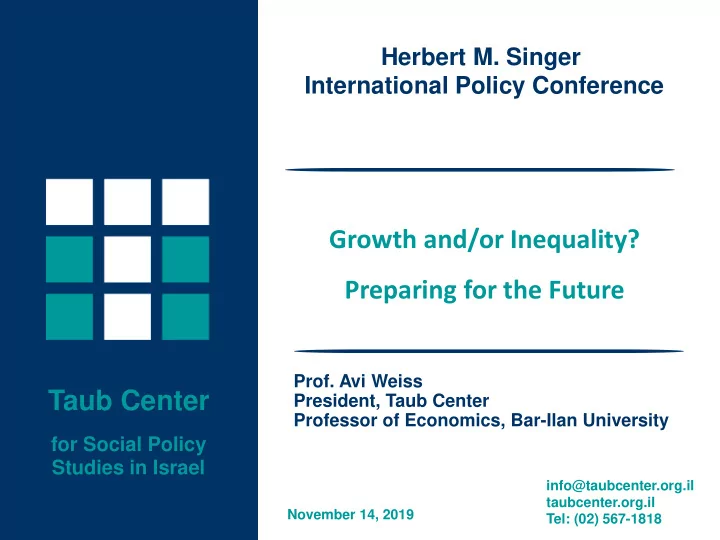

Herbert M. Singer International Policy Conference Growth and/or Inequality? Preparing for the Future Prof. Avi Weiss Taub Center President, Taub Center Professor of Economics, Bar-Ilan University for Social Policy Studies in Israel info@taubcenter.org.il taubcenter.org.il November 14, 2019 Tel: (02) 567-1818
The Kuznets (Inverted-U) Curve (1955) • Move from a rural society (agriculture based) to an urban society (cities) results in Inequality increased incomes for those who move, thereby leading initially to greater inequality • Once a large portion becomes urbanized, the continued flow continues to increase income, but also lowers inequality as more people earn “ city ” wages • Other changes, such as use of modern technologies, can yield the same type of dynamic Income per capita
Growth and Inequality – A dynamic • Socialist economy (A Kibbutz): all income is pooled and equally divided no inequality • Open economy to free trade and allow capital accumulation Increased growth as incentives lead to increased effort and entrepreneurial activities Increase inequality as some succeed more and some less • The less successful – those in (relative or absolute) poverty could face inequality in opportunities , and not just in income or wealth, and a distortion of incentives Poor access to imperfect credit markets Poor access to quality education Stress that affects productivity Welfare benefits distort labor market decision (education and participation) Lower income individuals have a greater incentive to engage in crime, etc. • As the inequalities grow these distortions increase, which can lead to a decrease in growth as the potential of the population is not realized Increased inequality in opportunities may lead to Decreased growth
The processes that link between family socioeconomic background and cognitive development and academic achievement Parenting styles Stress Cognitive Socioeconomic development and background educational achievements Sensory stimulation Qualtiy of education Source: Dana Vaknin, Yossi Shavit, and Isaac Sasson, Taub Center
Children birth to age 2 Predicted score on the Meitzav exam in math, grade 5 Children ages 3 to 5 Source: Dana Vaknin, Yossi Shavit, and Isaac Sasson, Taub Center Data: CBS
Growth and Inequality in Israel
The real cumulative change in household income and consumption, 2012-2017 Income quintile Note: the real change is calculated using a differential price index that utilizes each income quintile ’ s consumption basket. Source: Gilad Brand, Taub Center | Data: CBS, Household Expenditure Survey
The Gini index and GDP per capita in Israel Index year: 1998=100 Gini index GDP per capita (disposable income) 160 0.40 140 0.39 120 0.38 100 0.37 80 0.36 60 0.35 40 0.34 20 0.33 0 0.32 Source: Gilad Brand, Taub Center | Data: IMF, NII
Gini index after taxes and transfer payments in Israel and selected countries, 1998-2017 0.40 US 0.38 0.36 ISRAEL UK 0.34 0.32 Canada France 0.30 Germany 0.28 Finland 0.26 0.24 1998 2000 2002 2004 2006 2008 2010 2012 2014 2017 Source: Benjamin Bental and Gilad Brand, Taub Center | Data: OECD.Stat
Return to academic studies, selected OECD countries, 2012-2015 Upper half of the skills distribution 62.7% 100% 80% 60% 33.3% 32.8% 40% 20% 0% -20% Lower half of the skills distribution 55.3% 100% 80% 60% 40% 9.4% 5.0% 20% 0% -20% Source: Gilad Brand, Taub Center | Data: OECD, PIAAC
Thank you!! Prof. Avi Weiss President, Taub Center Professor, Bar-Ilan University info@taubcenter.org.il taubcenter.org.il September 2019 Tel: (02) 567-1818
Recommend
More recommend